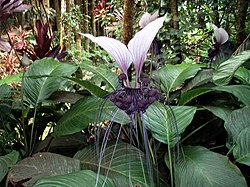| Bat flowers | |
|---|---|
 | |
| White Bat Flower ( Tacca integrifolia ) | |
| Scientific classification | |
| Kingdom: | Plantae |
| Clade: | Tracheophytes |
| Clade: | Angiosperms |
| Clade: | Monocots |
| Order: | Dioscoreales |
| Family: | Dioscoreaceae |
| Genus: | Tacca J.R.Forst. & G.Forst. |
| Synonyms [1] | |
| |
The genus Tacca, which includes the batflowers and arrowroot, consists of flowering plants in the order Dioscoreales, native to tropical regions of South America, Africa, Australia, Southeast Asia, and various Oceanic islands. [1] In older texts, the genus was treated in its own family Taccaceae, but the 2003 APG II system incorporates it into the family Dioscoreaceae. [2] The APG III and APG IV systems continue to include Tacca in Dioscoreaceae. [3] [4]




